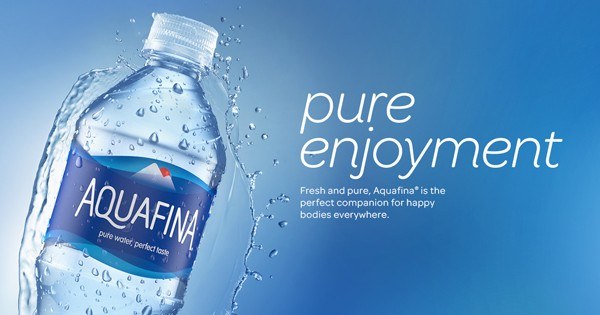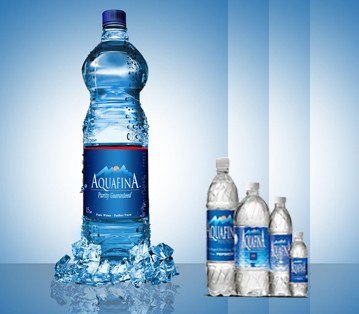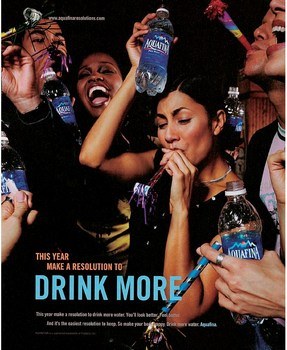The Marketing mix of Aquafina analyses the 4Ps of Aquafina’s marketing strategy, which includes the Product, Price, Place, and Promotion of Aquafina. Aquafina is brand of PepsiCo. It is headquartered in New York. PepsiCo was the outcome of the merger of Pepsi Coca-Cola Company and Lay–Fruit Inc., which took place in 1965. The company is known for manufacturing various snacks and fruit drinks. It has a great hold in the consumer market. Aquafina is one of PepsiCo’s profitable ventures. Net revenue assessment makes PepsiCo the second largest company in the world, which enjoys a monopoly in North America. Besides Aquafina, PepsiCo has the following brands: Miranda &up, Cheetos, etc.
Aquafina is the first bottled water brand owned by an arm of Pepsico, dealing in selling bottled water to consumers and businesses. The first Aquafina sale was marked in 1994 in Wichita, Kanas. Soon, it started spreading all over the world. 2003 was celebrated as the year of success, and Aquafina was the best-selling bottled water in the U.S.
The bottled water industry, which packages natural minerals and potable water, has grown tremendously, so Aquafina faces competition from many companies. The biggest competitor of Aquafina is Kinley Water of Coca-Cola. In India, Bisleri is the biggest competitor for Aquafina, and Bisleri dominates the Indian market.
In India’s emerging markets, there is a lot of local competition. Besides the international labels, the consumer market is hit by the local and regional bottled brands, which largely affects Aquafina’s hold in the market.
About Aquafina
- Type: Bottled water
- Industry: Beverage
- Founded: 1994
- Founder: PepsiCo
- Headquarters: New York, United States
- Area served: Worldwide
- Key people: Ramon Laguarta (Chairman) and Ramon Laguarta (CEO)
- Number of employees: 262,000
Table of Contents
Aquafina Product Strategy
Water is an easily accessible resource in many regions but is scarce in many places. Another factor is the fear in consumers’ minds as they want to drink R.O. filtered water or bottled water only, which is clean. Water can be an accessible resource, but pure water or drinking water is not accessible. Tap water can be a storehouse of germs and bacteria, which is why bottled water is a helpful resort.
To health-conscious consumers and keep up the sanctity of bottled water, Aquafina has developed technologies to filter water and provide the best quality bottled water to consumers. Recently, Aquafina purchased the Hydro 7 filtration technology from PepsiCo. The new low-calorie water is the added product on the Aquafina list.
Besides manufacturing the crystal-clear bottled water under the Aquafina label, PepsiCo also has products like Aquafina flavored waters in flavors like raspberry, grapes, berry blast, etc. A major consumer of Bottled water is companies in the beverage sector. The 20-liter water jar is famous as it is supplied in bulk to corporations that don’t have space to keep larger water coolers and who prefer bottled water.
Bottled water comes in various sizes. The larger sizes are meant for corporates, but smaller sizes are indicated for residential customers. Aquafina also has bottled drinking water that comes in 1-liter and 2-liter PET bottles, and it has started 5-liter PET bottles as well. Individual consumers use these. In parties and functions, Aquafina has started the 300 ml and 500 ml PET bottles served quickly to guests.
The Product Mix of Aquafina in 2023 is as follows (Source)
- Aquafina Purified Drinking Water: This is the core product of the Aquafina brand. Purified drinking water undergoes a filtration process to remove impurities and contaminants, resulting in clean and refreshing water.
- Aquafina Flavored Water: Aquafina may offer flavored water variations that combine purified water with natural fruit flavors. These flavored water products provide a more refreshing and enjoyable drinking experience for those who prefer a hint of flavor.
- Aquafina Sparkling Water: Some variations of Aquafina may include sparkling water options. These carbonated waters offer a fizzy and refreshing alternative to still water, often with natural flavors for added taste.
- Aquafina Plus+: Aquafina Plus+ is a line of enhanced water products that may contain added electrolytes, minerals, or vitamins to provide additional hydration benefits. These products are designed for those seeking more than just basic hydration.
Aquafina Place Strategy
Aquafina is like a regular product that is sold commonly. The company uses wholesalers as the middlemen to sell out its products. Retailers act as key to Aquafina’s business. Aquafina has countless middlemen and distributors worldwide, making the product easily reach out to the commoner. Distributors, wholesalers, and retailers make it easy for people to buy Aquafina.
One of the key factors in the sale of the product is availability. If it’s bottled water, and if it is available, consumers are unlikely to look at the brand. They are more likely to purchase bottled water because it is an essential commodity. A human cannot go without water for longer times. So, the success of the company depends on the various distribution channels.
As of 2009, Aquafina was the largest seller of Bottled water in the USA. However, it isn’t easy to get the actual statistics on the sale of bottled water in the USA or Other countries. In India, it is even more difficult because of the countless regional and local players in the target market of Bottled water. In Grade Town, Aquafina and Bisleri dominate the market. But the fight is between Bisleri and other local and regional products in B-grade and C-grade towns.
Here’s a place strategy for Aquafina:
- Retail Distribution: Aquafina’s place strategy relies on extensive retail distribution. The brand’s bottled water products are widely available in various retail outlets, including grocery stores, convenience stores, gas stations, and big-box retailers. This broad distribution ensures accessibility and convenience for customers.
- Vending Machines: Aquafina is often found in vending machines located in public places, office buildings, schools, and recreational facilities. This placement strategy capitalizes on high-traffic areas to make Aquafina accessible to people on the go.
- Foodservice and Hospitality: Aquafina is commonly offered in restaurants, hotels, cafes, and other food service establishments. Its presence in the hospitality industry ensures that customers can enjoy purified drinking water when dining out or staying in hotels.
- Online Sales: Aquafina may have an online sales presence through its parent company’s (PepsiCo) e-commerce platforms or partnerships with online retailers. This allows customers to purchase Aquafina products for home or office delivery.
- International Distribution: Aquafina’s global distribution strategy extends its presence beyond domestic markets. The brand is often available in international markets, catering to a diverse customer base and meeting the demand for bottled water worldwide.
Aquafina Pricing Strategy
Price is a significant factor because the differentiation is minimal in the bottled water market. The pricing of branded products is higher because of the transportation involved from the manufacturing hub to the consumer. At the same time, the money invested in branding and advertising also makes it costlier. The bottle might not be more expensive to the end consumer, but the margins to the intermediaries might be lesser, because of which sale gets affected. The intermediaries push those products where the margin is higher. However, with Aquafina’s high brand equity, it is safe to say that when the consumer is presented with the same product at the same price, he will prefer Aquafina over others.
The bottled water industry has gained quite a lot of momentum. Though water is a natural resource available freely, bottled water forms an exception in it. The different packaging is rated differently. Price is essential in targeting consumers and generating revenue, so Aquafina is quite selective with its prices. The prices in other nations and elsewhere are decided per the consumer market. It is mainly COMPETITIVE PRICING because Aquafina also adjusts its competitive pricing strategy per the competition’s offer.
Aquafina is cost-effective pure water that is treated with a high filter mechanism. They target their market segmentation of the medium–income group for their products, keeping in mind the health-conscious people from age 25 to 35.
Here’s an analysis of Aquafina’s pricing strategy:
- Cost-Plus Pricing: Aquafina’s pricing strategy may incorporate a cost-plus approach. This means that the base price of bottled water is determined by calculating production costs, which include expenses related to purification, packaging, distribution, and overhead. A predetermined profit margin is then added to set the final selling price.
- Market-Based Pricing: Aquafina closely monitors the pricing of competing bottled water brands within the market. By assessing the prices of similar products, Aquafina can adjust its pricing to remain competitive while maintaining a margin that reflects its product quality and brand positioning.
- Skimming Pricing: Aquafina may employ a skimming pricing strategy in certain situations, especially during product launches or when introducing new packaging sizes or variations. This involves setting a higher initial price to capture early adopters and consumers willing to pay a premium for perceived quality and purity.
- Promotional Pricing: Aquafina may offer promotional pricing to stimulate demand or gain market share during specific periods. Promotions might include discounts, bundle deals, or limited-time offers. These strategies can attract price-conscious consumers and increase sales volume temporarily.
- Premium Brand Positioning: Aquafina is a premium bottled water brand known for its purification process and quality. This premium brand image allows Aquafina to command a price premium over some competitors, as consumers are willing to pay more for a trusted, reliable source of purified drinking water.
- Economy Packaging: Aquafina may offer different packaging sizes, including economy or value packs, to cater to a wide range of customer budgets and preferences. This provides options for cost-conscious consumers who want the benefits of purified water without the premium price tag.
- Value Proposition: Aquafina’s pricing strategy emphasizes the value proposition it offers to customers. By highlighting the health benefits of purified water and the convenience of on-the-go hydration, Aquafina justifies its pricing as a reasonable investment in well-being and lifestyle.
Aquafina Promotion Strategy
Promotion is a necessary business activity to keep up with the consumer market. It has used the conventional promotion technique to reach out to its consumers. They have indulged in television advertisements, ads in print, and social media marketing to reach out maximum to the local population at low cost.
Without creating much of a dilemma, Aquafina’s marketing strategy clearly states that they are a pure water brand free from bacteria and germs. The promotion aims to reach the consumers locally, which is why a simple promotional gimmick is used.
However, when compared with its major competitor – Bisleri, in India, there is a lot to be desired from Aquafina marketing here. Globally, though, Aquafina is known to be a savvy marketer with many local point-of-purchase branding, advertising, regular promotional offers, and sales discounts to push its products into the market.
Some Recent Video ads and Print ads of Aquafina are:
AQUAFINA PADI OF LIFE TVC – YouTube
Liked this post? Check out the complete series on Marketing Mix



I received a email wanting to use my car to promote your product. I don’t know what to think. Is it a real offer. Or is it some sort of scam?
It sounds like a good idea, but is it legitimate?
Please let me know!
I received a email wanting to use my car to promote your product. I don’t know what to think. Is it a real offer. Or is it some sort of scam?
It sounds like a good idea, but is it legitimate?
Please let me know!
Are you working for the company (Aquafina) or do you work with their marketing firm?